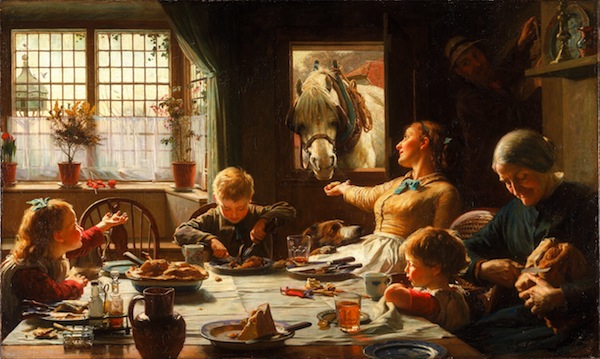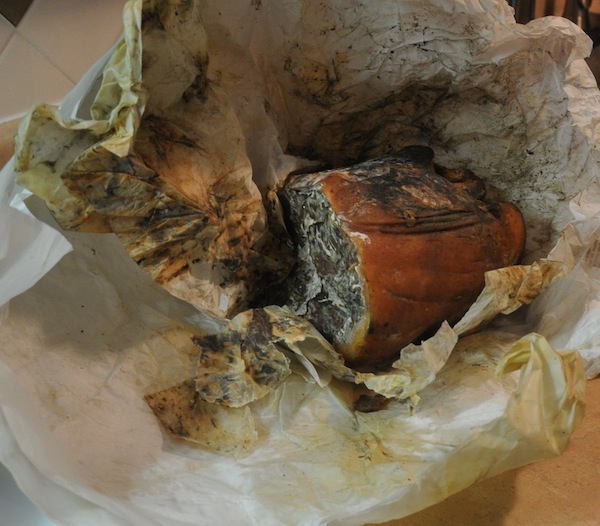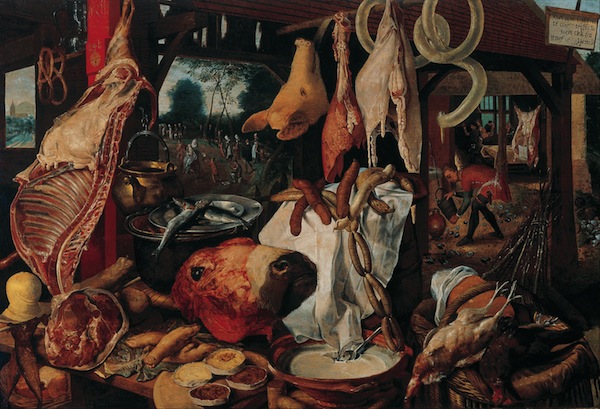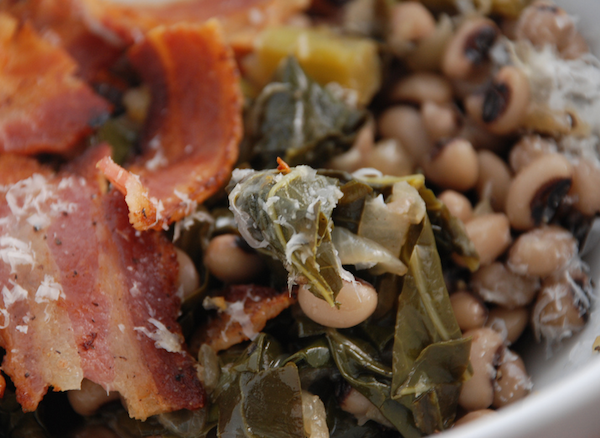Hoppin’ John: Poor Man’s Fare for New Year’s Wealth
“I simply knew I had to have my Hoppin’ John on January 1st. Tradition declares that it is imperative to do so in order to assure good luck—specifically, financial good luck—for the coming year. Somehow, I had to gather the ingredients and construct my New Year’s Day meal.”—William A. Balk, Jr.
Epicurus’ Porch
By William A. Balk, Jr.

 BEAUFORT South Carolina—(Weekly Hubris)—12/30/2013—In a previous incarnation, I spent some 20 years in Washington, DC. I was young—only in my 20s when I arrived—and my exposure to cosmopolitan life had been gained living through tumultuous social change at a red-brick, Southern university.
BEAUFORT South Carolina—(Weekly Hubris)—12/30/2013—In a previous incarnation, I spent some 20 years in Washington, DC. I was young—only in my 20s when I arrived—and my exposure to cosmopolitan life had been gained living through tumultuous social change at a red-brick, Southern university.
Rather astonishingly, I soon found myself at the center of a creative, intellectual, and cultural community comprising artists in many media and disciplines—writers and poets, journalists for publications and for television—and I came to know people from all parts of my own country as well as countries all round the world. In the homes of refugees and diplomats, I tasted foods I’d never heard of; I shared happily in religious traditions completely alien to my upbringing and to my own agnosticism.
I spent several years in this glorious cultural stew, a sponge soaking up more culture and art and human wealth than I ever dreamed I would know; but I began to realize that many of the people I had met had little knowledge of the culture from which I, myself, had come. Nothing of my own background, I thought, could possibly be of interest to these marvelous sophisticates.
One year, when I’d not been able to return to South Carolina for the family Christmas gathering, I’d stayed in Washington for the holidays and shared festive meals with many friends. There were Christmas dinners and small gatherings for Hanukkah; we celebrated the Winter Solstice in multiple ways. The depth of that winter and the end of a year brought out a communal impulse for gathering friends and sharing traditions, and my Christmas away from home left me, thankfully, only mildly homesick.
Several days before that New Year’s Eve, however, I developed a strong craving for the traditional Southern food with which we always bring in the New Year back home. This was odd: I had rarely yearned for the dish called Hoppin’ John when I was living at home, and I had only occasionally had it on New Year’s Day while I was away at college. While I enjoyed each of its ingredients, the dish had no mystique for me . . . until that year—“in exile” from The South—in Washington.
I simply knew I had to have my Hoppin’ John on January 1st! Tradition declares that it is imperative to do so in order to assure good luck—specifically, financial good luck—for the coming year. Somehow, I had to gather the ingredients and construct my New Year’s Day meal.
I set about locating decent greens and peas and salt pork. Rice I had plenty of—I did retain enough of my culinary Carolina upbringing never to be without plenty of rice in my pantry. As I wandered the markets that day, I thought how much fun it would be to prepare a large enough batch of Hoppin’ John to share with a few friends. I found excellent collard greens in the Latino neighborhood a few blocks away—far better than the pitiful greens in my local Safeway. Black-eyed peas were the easiest peas to find, and I could choose dried, canned, or frozen. Salt pork was also better in the Latino stores, so I got enough to flavor the peas and the greens while they cooked.
Gathering up more than I had originally planned, I took these ingredients of the traditional recipe, cooked them as I had seen my mother and grandmother do so before me, and prepared small casserole dishes filled with Hoppin’ John. I had eight dishes, enough to carry to eight friends who lived in downtown Washington, leaving a substantial dish for my own meal the next day.
I packed my nicely-wrapped dishes, wrote a brief history of the tradition of Hoppin’ John and its ingredients, and included the admonition that one must eat some on New Year’s Day to assure monetary success in the New Year, adding my personal guarantee that it would work. I called a cab and made my deliveries, wished each friend a Happy New Year, and went on my way.
On New Year’s Day, I had my own serving of Hoppin’ John. It was fine but, certainly, not the exceptional dish I had imagined. That afternoon, however, I began receiving calls from the friends who’d received my deliveries of the day before. These were not simply the polite thank-you calls one might expect but, rather, each caller expressed gratitude and pleasure, delight in the novel dish, itself, but also a particular joy at having been invited to share in a unique and new-to-them tradition from a culture they barely knew. My little impulsive gesture—despite its imperfect execution—had been a success.
Thus began my own New Year’s tradition, which I continued, improved upon, expanded, and improved upon yet again through my years in Washington and even after I returned home to the South Carolina Low Country. I prepared my little casseroles in Beaufort for a couple of years until I realized, as I delivered Hoppin’ John to some friends on Newcastle Street, that I was truly delivering . . . coles to Newcastle! (For those not in the know, the cabbage is a member of the coles: hence, our cole slaw.) The pun brought me up short: people here certainly don’t need to be introduced to the pleasures of Hoppin’ John, and my deliveries, though welcomed, lacked the resonance of the act among Washingtonians new to The South’s regional and seasonal delicacies.
Nevertheless, my decades of experimentation, study and tasting had resulted in a rather untraditional approach which yielded a particularly rich and luscious—and, indeed, even authentic—Hoppin’ John.

Greens
There’s a reason cole crops—from the Brassica family—are the usual greens associated with Hoppin’ John; these leafy vegetables, such as cabbage, grow wonderfully through the winter in the South. Indeed, most are actually better when they’re picked after a freeze. Collard greens are the quintessential Hoppin’ John greens, but turnip greens, mustard greens, or other Brassicas are often used. My current favorite is kale but, on many occasions, I have used spinach greens, even though they’re not in the cole family.
It’s important to understand the character of the leaf you’re working with. Younger leaves of most greens are fine. Older leaves—and all collard leaves—usually have a rather tough center rib. Removing the rib will result in a much more even texture in the final dish, and slightly less bitterness.
Fresh greens do make for a remarkable dish; however, frozen greens have sometimes found their way into my Hoppin’ John, and I have found no reason to complain.
Peas
Black-eyed peas are the ones most readily associated with Hoppin’ John. They’re perfectly suitable for the dish, as are most of their relatives—field peas, cowpeas, pink-eye peas, purple hull peas, etc. My favorites are lady peas, a tiny, extra-sweet version; they’re sometimes called cream peas and are also usually quite hard to find.
At New Year’s, peas are not going to be in season, and unavailable unless they’ve been flown in from some distant locale. Ideal would be peas frozen or canned from one’s own garden. Second best would be frozen peas. Commercial canned peas are a distant third choice.
Rice
Rice is a constant in Carolina cooking. Here, “rice” means long-grained white rice, not “converted” rice, not short-grained Italian or Japanese rice, not sticky rice. It must cook to a perfect texture and maintain perfectly separate individual grains. This can only be done by boiling it in a huge pot with lots of water. Brown rice, if long-grained, may be successfully cooked in this way, too, although the cooking time will need to be increased. I’ve found that the only way to be assured of perfectly cooked rice is constantly to stir and constantly taste. Once the grains are just al dente, the rice must be immediately removed from the heat, poured into a large colander, and rinsed with cold water to stop its cooking further.

Pork
The cuts of pork usually used for traditional Hoppin’ John are salt pork and fat back. Sometimes, bacon is used. These are richly flavored and provide calories required by those doing hard, manual labor. I’ve come to prefer using country-cured, dry-hung, aged ham. We often have such a ham for Christmas dinner, so there’s plenty left to use in the Hoppin’ John. Most grocers now stock slices of country ham, and these are perfectly fine for use in the dish. While I have hung and aged our dry-cured hams for as long as a year, producing a prosciutto-like ham to be sliced tissue-thin and served uncooked, we usually cook our hams.
Those are the classic ingredients for Hoppin’ John, but I add a few other flavors to deepen and enrich the final effect.
I consider pecans an essential and heavenly ingredient in my own Hoppin’ John. I like to toast the pecan halves in the oven just to the point of fragrance. Then, I let them cool and slice them length-wise into two or three long pieces, an affectation I’ve adopted because it looks just right in the final dish. Certainly, pecan pieces will work just as well.
Sliced onions, the highly-flavored ones and not the mild Vidalia type, provide a depth of flavor otherwise unobtainable.
Peppers, in the form of hot red pepper flakes or chopped fresh chilies, give piquancy and bite.
Salt and ground black pepper will probably be required, for balance and taste.
Cooking traditional Hoppin’ John was always a simple and straightforward affair; the greens were washed, chopped (or left whole, if small), then cooked down with the fatty pork for a long period. Peas —usually dried peas—were soaked in one or two changes of water, at least overnight. The drained, soaked peas were then cooked for hours in water along with pieces of salty pork. Rice was cooked in a huge boiling pot until perfect for serving; then drained, rinsed, and placed in a colander over steaming water. Each plate was filled with a serving of these three basic ingredients: Hoppin’ John for the New Year.
My Hoppin’ John instead is a single concoction comprising all the ingredients. I prepare each ingredient separately, cooking each until slightly underdone. The washed and cut greens are lightly sautéed in a little olive oil, then set aside. The peas (thawed if frozen, soaked if dried) are cooked until just barely soft in salt-free chicken stock or water (replenished if it cooks off), and set aside. The ham, I cut into small slivers ¼ inch (6-7 mm) wide and—unless already cooked—lightly sauté with just a tiny bit of olive oil and set aside.
The rice is cooked in lots of boiling water until just al dente, drained, rinsed, and set aside. The pecans are toasted and sliced. The onions are chopped and sautéed, also in a little olive oil. All is tasted and approved. Everything is left to cool, since the dish will be assembled in appropriately sized, oven-proof dishes or casseroles; preferably left to sit while flavors marry, and then reheated.
With everything cooked and ready to assemble, I get out my giant mixing bowl. I start with the rice, which should make up about ½ or a little more of the finished mixture. For six servings of Hoppin’ John as a one-dish meal, I put into the big bowl about 8 cups (2 l.) of cooked rice. Then I put over the rice in the bowl about 4 cups (1 l.) of cooked greens, which I then stir and mix well into the rice. Next, I add about 4 cups (1 l.) of cooked peas; and, again, I mix that in thoroughly. Then, there is the country ham, which I mix in well. For six servings, I will add about three cups (750 ml.) of toasted pecans—I really do love pecans. I will add the sautéed onions, pepper flakes, salt and pepper—all according to taste. A final mixing, and then I like to leave the mixture to sit in the refrigerator for at least 4 hours to let flavors mingle a bit.
This is a lot of Hoppin’ John, so I usually divide it into two oven dishes, covered, and put them in the oven at about 275 Fahrenheit or 135 Celsius for 30 to 40 minutes. Everything is already cooked, so all this does is heat the food to serving temperature.
When it is heated through, remove from the oven, uncover, and serve with corn bread (to be traditional), and sweet iced tea. And be sure to consume it on New Year’s Day!
You are assured then of prosperity for at least the coming year.
Should you have leftovers, and I try to make too much every time, try briefly dipping collard leaves (stiff ribs removed) into boiling water to soften, and then rolling up little dolmádes with the Hoppin’ John mixture as the filling. Reheat with a little lemon-butter-chopped pecan sauce, and you have wonderful light supper (for January 2nd).

Ingredients
Hoppin’ John for Six
Greens: 1 large bunch of collards or 3- 4 smaller bunches of smaller greens. You should end up with at least 4 cups (1 l.) of cooked greens, and they cook down dramatically. Or buy frozen greens, approximately 20 oz. (570 g.) of frozen greens for six servings.
Peas: fresh or frozen. Plan on about 4 cups (1 l.) for six servings, or about 20 oz. (570 g.) frozen.
Pork: two or three whole slices of country ham cut ¼ inch (6-7 mm.) thick, then into narrow ¼-inch strips and then into inch-long pieces should be adequate. If you’ve cooked a whole ham, it should be ready to cut up and mix into the other ingredients. If it’s the packaged slices, you may want to sauté the cut-up strips before mixing it into the Hoppin’ John.
Pecans: the best come from your own trees, of course. The packaged ones from stores should be stored in the freezer until needed, or used quite quickly. Using chopped nuts will work fine with this recipe. When I toast them, I use a low temperature—not higher than 200 degrees F or 95 degrees C —and watch closely to keep them from browning too much and turning bitter.
Onions: the common yellow, white, or red onions are best for this recipe. The mild Vidalia types don’t provide enough flavor to make a difference.

May your New Year bring health, happiness, and prosperity to you and those you love. At least one of those three eventualities may now be assured in 2014, if you get busy in the kitchen!

12 Comments
alice
Yum! I love pecans in everything also and your dolmades idea – just fabulous! Thanks for the inspiration dear friend.
Katherine Lang
Will, I am always delighted by your columns, and by you! Leftover Hoppin’ John is also good when turned into soup with the addition of more chicken broth, which freezes well and gives a “booster shot” of good luck when most needed in February!
Happy New Year-
Katherine
Teresa Bruce
The best fortune of all is having you share your recipe! I can’t wait to try, and Katherine — love the soup idea too.
Will
Lordy – I haven’t even had my Hoppin’ John yet, and just look at the good fortune brought my way! Thank you, Katherine, for the perfect follow-up recipe; and to you, Alice, and Teresa – may the New Year bring you prosperity, great health, and happy times to remember!
gary geboy
Being from the north, Hoppin’ John was completely new to me my first year in South Carolina. But I have to admit, receiving a plate with beans, greens and some sort of pork laid out in neat little piles left alot to be desired. Until one new years morning someone put a nice little package outside our door. It looked like some type of casserole, that I could understand with my midwest as well as northern sensibilities. It was Wills Hoppin’ John. What a treat that morning. I still can’t go with the neat little piles, but Will, we still live in the same place.
Have a great New Year buddy.
Will
Awww, Gary. You know I will do anything to keep you making those magical photographs. That little dish of Hoppin’ John was just to assure the fabulous wealth that was to come to you that year! At least, I THINK it came that year…right?
Anne Roberts
This is a saver, to savor! In my early days on Bay Street, I was a lucky recipient of your New Year’s Hoppin’ John and I caught the obsession with this dish full of good omens. I’ve tried to wing it on my own, always blaming the fact that I had no home cured ham or farm peas on my inability to produce the right deliciousness. After reading about the history and hints of chili peppers, pecans and the right onion, I’m inspired. Happy New Year Will!
Will
Get to it, Anne! The happiest of New Years to you, too, and to all you love!
Laura Lee Rose
Making my mouth water; I’m looking forward to making Hoppin John and eating it with friends and family after the Pelican Plunge tomorrow.
Happy Wonderful New Year!!
Will
You make me shiver, Laura Lee, just thinking about the Plunge! Happy New Year!
Jay Weidner
Hey Will, I read your post and got hungry. Being too lazy to go out for fresh ingredients, I pulled out a can of Margaret Holmes turnip greens and her black eye peas too from the pantry. Then I found a nice chunk of country ham in the fridge and chopped up an onion and put on a pot of brown rice. I’m on my way, just not as good as yours from scratch. I can tell the final plate will be a little salty. Thanks for the inspiration, Bubba!
Will
Mercy, Jay! Of course, I was certain you’d have Hoppin’ John today, it tickles me enormously that you’re using this recipe for your inspiration. I’m pleased you found the essay. I know yours will be a glorious and prosperous New Year.